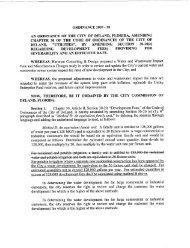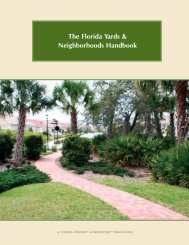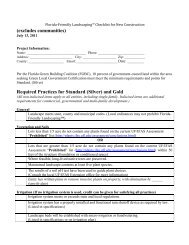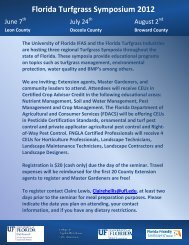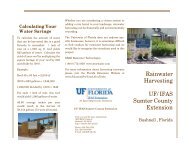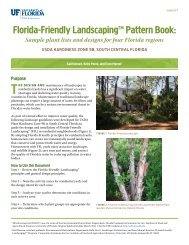A Guide to Florida-Friendly Landscaping A Guide to Florida-Fr ...
A Guide to Florida-Friendly Landscaping A Guide to Florida-Fr ...
A Guide to Florida-Friendly Landscaping A Guide to Florida-Fr ...
Create successful ePaper yourself
Turn your PDF publications into a flip-book with our unique Google optimized e-Paper software.
Scientific name<br />
Common Name(s)<br />
Itea virginica<br />
Virginia Willow, Virginia<br />
Sweetspire<br />
Region<br />
NC<br />
8-9<br />
Native<br />
or NI<br />
FL<br />
Growth<br />
Height<br />
Spread<br />
Slow<br />
3-8<br />
2-4<br />
Soil<br />
pH,<br />
text.<br />
<br />
S/L<br />
Soil<br />
Moisture/<br />
Drought<br />
Medium<br />
Light Range/<br />
Optimum<br />
Salt<br />
L-N<br />
Comments<br />
white flowers in spring-summer; good plant for edges<br />
of retention ponds, swales and canals; occurs<br />
naturally in wet soils but may adapt <strong>to</strong> dry conditions<br />
(performs best with moderate moisture)<br />
Jasminum multiflorum<br />
Downy Jasmine<br />
CS<br />
9b-<br />
11<br />
NN<br />
Fast<br />
5-10<br />
5-10<br />
<br />
Any<br />
Medium<br />
L-N<br />
white, fragrant flowers all year; dies back when cold<br />
and comes back; pest sensitive<br />
Jasminum nitidum<br />
Star Jasmine, Shining<br />
Jasmine<br />
Fast<br />
CS<br />
9-11 NN 20<br />
10<br />
<br />
S/L<br />
Medium<br />
L-N<br />
white, fragrant flowers in spring <strong>to</strong> summer<br />
Jatropha integerrima<br />
Peregrina<br />
CS<br />
9b-<br />
11<br />
NN<br />
Med.<br />
15<br />
10<br />
<br />
Any<br />
High<br />
L-N<br />
scarlet flowers all year; very poisonous, use with<br />
caution; watch for scales and mealybugs; sensitive <strong>to</strong><br />
frost<br />
Juniperus chinensis and<br />
cvs.<br />
Chinese Juniper, Japanese<br />
Juniper<br />
Ligustrum japonicum and<br />
cvs.<br />
Ligustrum, Japanese<br />
Privet<br />
Loropetalum chinense<br />
and cvs<br />
Loropetalum, Chinese<br />
<strong>Fr</strong>inge Bush<br />
NC<br />
8-9<br />
NCS<br />
8-<br />
10b<br />
NC<br />
8-9<br />
OK<br />
OK<br />
OK<br />
M-F<br />
varies<br />
varies<br />
Med.<br />
8-12<br />
15-25<br />
Med.<br />
6-15<br />
8-10<br />
<br />
S<br />
<br />
Any<br />
<br />
Any<br />
High<br />
High<br />
Medium<br />
M<br />
H<br />
L-N<br />
flammable - in wildfire-prone area, plant min. 30'<br />
from bldgs; does not <strong>to</strong>lerate wet feet; good pollution<br />
<strong>to</strong>lerance; watch for mites (especially when hot and<br />
dry), bagworms, root rot, Phomopsis blight<br />
white flowers, summer; watch for scale/whiteflies<br />
/sooty mold/nema<strong>to</strong>des/root rot; used as hedge; thins<br />
at bot<strong>to</strong>m unless in full sun; invasive assessment: not<br />
a problem, incomplete conclusion<br />
white/pink flowers in spring; size varies; no major<br />
pest problems but watch for mites/nema<strong>to</strong>des/root<br />
rot; eriophyid mites may be severe on cv 'Ruby'; in<br />
high pH soils may have minor element deficiencies<br />
32



